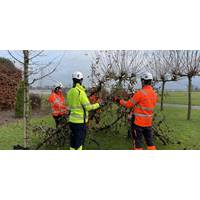
Van Oord, Ecowende to Enhance Biodiversity Hollandse Kust West Wind Farm
species.The Oyster Hubs will be installed in 2026 or 2027 on three cable crossings. Ecowende’s partner Waardenburg Ecology will measure and monitor the effects of these two innovations.The Ecowende wind farm (Hollandse Kust West Lot VI) will be located about 53 kilometres off the Dutch coast, near IJmuiden.The wind farm will have an operational capacity of 760 MW, making 3% of the current Dutch electricity demand greener.Ecowende plans to have the wind farm fully operational and commissioned by late 2026
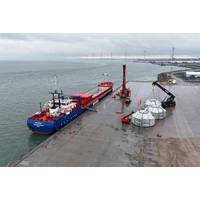
RWE to Protect Thor’s Offshore Wind Foundations with Reused Covers
to be adjusted and reused for different sizes of monopiles.It is expected that the individual panels of the covers could last 15 years and even more, depending on how often the diameter needs to be adjusted.The 72 covers for the Thor project were previously installed at an offshore wind farm off the Dutch coast.After their deployment at RWE’s Thor wind farm, the adjustable covers will be utilized at other upcoming offshore wind projects.Foundation installation work at Thor offshore wind farm, including the deployment of the reusable covers, will start in spring 2025, with turbine installation scheduled
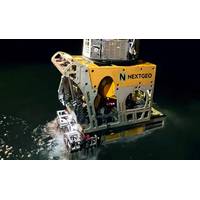
NextGeo Scoops $27.8M for North Sea Offshore Wind Surveys
Marine geosciences and offshore construction support services firm Next Geosolutions has been hired by TenneT under a $27.8 million contract to conduct an unexploded ordnances (UXO) survey off the Dutch coast, in support of the development of offshore wind farms.This contract involves the execution of marine UXO survey, to identify and locate magnetic anomalies potentially associated with unexploded ordnance, which may represent obstacles to the installation of new offshore infrastructure, in the Doordewind offshore wind area.Additionally, the contract includes an UXO survey in the Nederwiek offshore
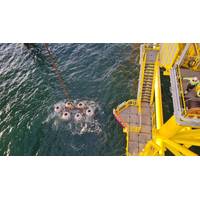
Artificial Reefs Deployed in Dutch North Sea to Boost Marine Life Around Offshore Wind Farms
these spots for shelter and to look for food," says Annemiek Hermans. As a marine biologist, she advises TenneT on nature-inclusive construction at sea. Ball or Cube?Credit: TenneTThe aim of the trial is to investigate which shape - ball or cube - works best in the waters off the Dutch coast. The hollows provide protection for young fish, but are also meant to increase the structure's bonding surface. "In this way, we hope to provide a suitable place for numerous other animal and plant species in addition to juvenile fish, crabs, and lobsters," Hermans said.
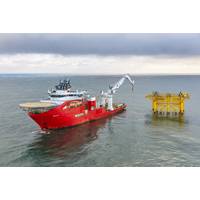
First Sea Cable Installed for TenneT's West Alpha Offshore Substation
offshore wind substation for Dutch grid operator TenneT. The offshore installation contractors used the cable-laying vessel Connector and the remote-controlled cable-laying vehicle UTV1200 for the operation.Over sixty kilometers of cable were laid in the seabed between the Heemskerk beach on the Dutch coast and the jacket foundation of the transformer platform at sea.With over sixty kilometers of marine cable on board, the cable-laying vessel Connector from contractor Jan de Nul's fleet appeared off the coast of Heemskerk/Wijk aan Zee in mid-December. This cable section completed the first
Kraken's PanGeo SubSea Completes Acoustic Corer Survey off the Dutch Coast
Kraken Robotics said that its PanGeo Subsea subsidiary completed an acoustic coring (AC) campaign for ONE-Dyas in the North Sea, the company's second AC survey at ONE-Dyas's GEMS development, supporting foundation engineering of the N05-A gas platforms.The campaign took place during the summer aboard the M/V Dina Star. PanGeo was the prime contractor for the project. The scope of work was to acquire an acoustic core at each of the 6 legs of the platform foundation, and an additional core centered on the wellhead. PanGeo high-resolution data is designed to identify geohazards such as
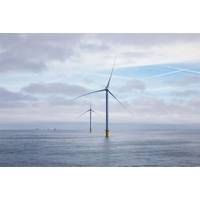
Dutch Build Out North Sea Wind Farms, Test Floating Solar Panels
Wind turbines, floating solar panels, and green hydrogen at sea are among the projects under construction off the Dutch coast, as a country famed for its water engineering prowess builds out its renewable energy infrastructure.On a tour of North Sea facilities on Aug. 25, companies and Dutch utilities showed off key projects.At Hollandse Kust Zuid, a 1.5 gigawatt (GW) wind farm scheduled for completion next year, ten out of the 140 turbines are already producing electricity. Sweden's Vattenfall made headlines when it won the concession to build the farm in 2018 without government subsidy.Electricity
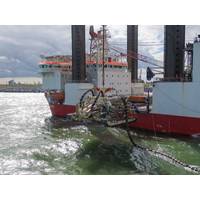
Van Oord Deploys Giant Trencher to Bury Offshore Wind Cables in North Sea
Dutch offshore installation contractor Van Oord has deployed a large remotely operated trencher called Deep Dig-It off the Dutch coast to bury offshore wind farm cables 5,5 meters deep into the seabed.The trencher has been deployed as part of the cable installation project for the Dutch grid operator TenneT's Hollandse Kust (zuid) offshore grid construction to connect new offshore wind farms, which will see four cables buried in the North Sea.For the first ten kilometres of the cable route at sea, the cables will have to be buried more than 5,5 meters into the seabed to safely cross the busy

Helping to Keep Waterways Navigable in the Netherlands
effects.The construction of the Afsluitdijk, a 32 km dike through the IJsselmeer and Wadden Sea, has resulted in a major morphological shift in the Dutch section of the Wadden Sea, one of the world’s largest tidal flats systems, which stretches from the Netherlands to Denmark.Off the northern Dutch coast, the sea bottom is rising and the maritime navigation channels for ferries are rapidly clogging up with sediments. The navigation channel for the ferry crossing between Holwerd and the island of Ameland has to be dredged around the clock to keep it accessible. Near the village of Holwerd, sedimentation


 February 2025
February 2025





